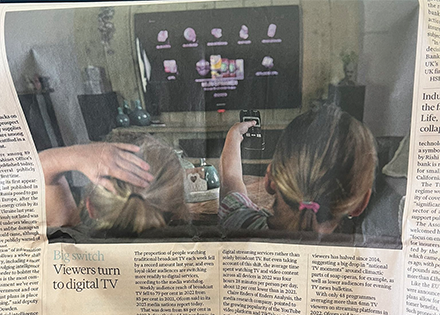 |
||||||||||
|
||||||||||
| The News: The Advertising Ecosystem Is Enjoying a Bit of a Rebound |
 |
| The Context: What a difference a few business quarters make! Back in Q1, all anyone could talk about was an impending recession. The advertising industry expected to take a massive hit as advertisers cut their spending and focused on retail media platforms. Expecting lower revenue, publishers announced layoffs, including The Washington Post, BDG, Recount, Gannett, Recurrent, CNN, Netflix, Acast, Future, Warner Bros. Discovery, G4, and others. We may still have a recession, although as of this writing, economics are beginning to walk back from that view. In advertising, three recent stories point to a growing optimism for the market, with short-form video leading the way. The Rebound Hero? Short-Form Video: Short-form video dominated in 2022, with brands posting them on virtually every social media site. According to a HubSpot survey of marketers, half of whom invested in short-form video plans to increase spending going forward. Current reports show that marketers have continued their investments in short-term video. DoubleVerify CEO Mark Zagorski told Yahoo Finance short-form videos on social media platforms are attracting advertising investments because they excel at driving customer engagement. Marketing Brew echoed Yahoo Finance, reporting that overall, programmatic advertising is growing, thanks largely to video. Citing research from Insider Intelligence, 96% of the growth in programmatic will stem from video. “Between 2021 and 2025, programmatic display ad spend is projected to grow from $60 billion to $72 billion, while spend on programmatic video inventory will grow from $55 billion to $97 billion,” writes Marketing Brew. The impact of video and, as we’ll see below, an economy that is more resilient than anticipated means that 2023 will be a better year for the advertising sector than we thought at the beginning of the year. Solid Growth in the Sector: Falling inflation and stronger consumer spending are contributing to the rebound. Procter & Gamble reported an 8% growth increase in organic sales, encouraging them to boost ad spend by $453 million last quarter, according to the company’s earnings report. Other CPG companies, such as L’Oréal, Unilever, Kimberly-Clark Corp., Nestlé, and Hershey Co. have also increased ad spend due to better organic sales. According to Axios, industry analysts are growing bullish on the sector, writing, “Analysts are optimistic that advertising growth will improve in the second half of the year, with data showing the economy moving in the right direction.” Brian Wieser, a top advertising analyst, said that given the red-hot advertising growth in 2020 and 2021, a slowdown was inevitable. But it’s important to keep that deceleration in perspective; no one should have expected advertising to grow at the same pace as during the pandemic years when so much of the sector was turned upside down. |
| Short-form video is a popular format, especially for the younger generations “??Gen Z typically have an attention span of just 8 seconds; a few seconds shorter than millennials, who come in at approximately 12 seconds,” writes IAB UK. They’re the ones that are driving its popularity and the rise in ad spend. Publishers, aware that the younger generations spend their time on social media platforms and that one in seven people aged 18 - 24 get their news from them, began building product teams to create short-form videos. According to Digiday, The Washington Post, The Wall Street Journal, CNN, and others view TikTok and Instagram as a way to build audiences. Rather than lure consumers away from the platforms to their sites, publishers are bringing the news to TikTok. It’s a strategy that works; in 2022, BBC News has seen a 2000% increase in its audience thanks to TikTok. A What’s New in Publishing’s Publishing Trends Report 2023, 59% of publishers say TikTok would be more important to them this year compared to 2022 — a jump of 39% percentage points in the last year. In fact, 47% of respondents said that growing social followers and engagement is their top priority. We should expect to see short-term video and social media sites grow in importance for publishers and for more to create dedicated teams that can bring the news (and advertising revenue) to the consumer, not the other way around. |
|
| Meta Platforms Block News Sites in Canada |
 |
| If we have learned anything over the past few years, big tech companies will not back down when they feel pushed into a corner. In June, Canada's Parliament approved the Online News Act, which compels digital companies to compensate domestic media outlets for links to their articles. Meta warned the Canadian government that they would block news articles on their platforms if the law passed. That time has come. "Changes will roll out over a few weeks," Meta spokesman Andy Stone announced on his official X account. "As we've always said, the law is based on a fundamentally flawed premise. And, regrettably, the only way we can reasonably comply is to end news availability in Canada." Google's parent company, Alphabet, said they will follow suit once authorities enforce the new regulations. Meanwhile, Prime Minister Trudeau fired back at Big Tech's tactics. "They made the wrong choice by deciding to attack Canada," said Trudeau. "Canadians will not be bullied by billionaires in the U.S." |
| This has been a long-standing battle between Big Tech and New Publishers. Big Tech vs. The News: Last year, the U.S. federal government attempted to pass the Journalism Competition and Preservation Act (JCPA), and Big Tech had a similar reaction. While the law passed through Congress, it failed to move through the Senate Judiciary Committee. In addition, California attempted to pass a similar state-level law, the CJPA, which would "allow local news outlets to work together to bargain with tech giants, such as Facebook and Google, to collect a fee for using their content and selling advertising alongside it." News publishers feel Big Tech is stealing some of their content and ad revenue. In addition, smaller and local publishers rely on social media to distribute their content to break through the oversaturation of the news cycle. Big tech's scare tactics harm them the most. This law would allow them to work together to get compensation, but Big Tech has never followed suit with these laws. Back in 2021, Facebook and Google chose to stop distributing news publishers' content in Australia. Meta said, "News publishers and broadcasters outside of Canada will continue to be able to post news links and content; however, that content will not be viewable by people in Canada." If the U.S. attempts and succeeds in passing a similar law, Meta and other big tech companies will most likely choose the same path. |
| Profitero Introduces AI-Powered Retail Analytics and GPT-Powered Chatbot |
 |
| Profitero, a retail analytics platform, recently unveiled two AI solutions to revolutionize data-driven decision-making for brands and retailers. These offerings comprise an AI-powered retail analytics platform and a GPT-powered chatbot, Ask Profitero, designed to analyze e-commerce data. With these tools, businesses can gain valuable insights into their digital shelf performance, pricing strategies, and consumer preferences, driving increased competitiveness and efficiency in the evolving retail landscape. By analyzing vast datasets from various online channels, brands and retailers can adjust their strategies swiftly to stay competitive. The platform's AI capabilities also facilitate the identification of emerging trends and consumer preferences, granting businesses a strategic edge in meeting customer demands. |
| The era of AI is in full effect. Since Generative AI took the world by storm, businesses in all industries have been experimenting with the tech to help their workflow efficiency. How is ad tech using it?
"We'll have to test this, but the potential is there to prioritize and ask, where am I winning organic search on certain keywords or a certain group?" said Todd Hassenfelt, Colgate-Palmolive's global digital commerce director for Strategy & Execution and early tester of the new tech. "Where do I have the biggest opportunity? Where can I improve my paid search results? With that information available faster, you can now look at how we allocate resources." |
| @{optoutfooterhtml}@ |











